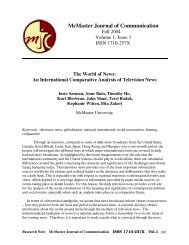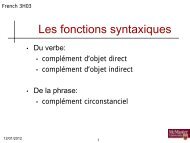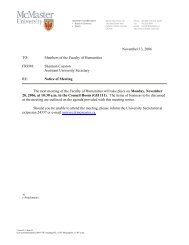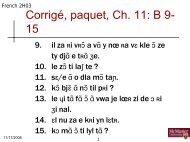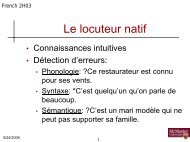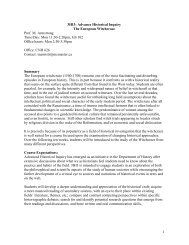The Syntax of Givenness Ivona Kucerová
The Syntax of Givenness Ivona Kucerová
The Syntax of Givenness Ivona Kucerová
Create successful ePaper yourself
Turn your PDF publications into a flip-book with our unique Google optimized e-Paper software.
‘Marie will give the/a horse to Pavel.’<br />
Furthermore, the three hypotheses make different predictions with respect to the distribution<br />
<strong>of</strong> adverbs. I assume that adverbs in Czech, with the exception <strong>of</strong> prosodically heavy<br />
adverbs, are left branching and adjoin immediately to a functional head. Thus, for example<br />
a vP adverb can linearly intervene between the subject and the finite verb in v. 8 Consider<br />
the examples in (18). Time adverbials, such as yesterday, that are base generated at vP may<br />
precede the finite verb and both the direct and indirect object, irrespective <strong>of</strong> the word order<br />
<strong>of</strong> the objects. If G-movement <strong>of</strong> the direct object took place only at the phase level, this<br />
order would be unexpected without additional assumptions about movement <strong>of</strong> adverbs.<br />
Thus, we can conclude that the reordering <strong>of</strong> the direct and indirect object takes place<br />
within vP.<br />
(18) vP adverbs:<br />
a. Marie [ vP včera dala Petrovi<br />
Marie.Nom yesterday gave to-Peter.Dat<br />
‘Marie gave yesterday Peter a horse.’<br />
b. Marie [ vP včera dala koně<br />
Marie.Nom yesterday gave horse.Acc<br />
‘Marie gave yesterday a horse to Pavel.’<br />
koně].<br />
horse.Acc<br />
Pavlovi].<br />
Pavel.Dat<br />
We can further restrict the domain <strong>of</strong> the reordering by looking at VP adverbs. Assuming<br />
that VP adverbs adjoin to VP, we predict that if G-movement targets the end <strong>of</strong> the maximal<br />
projection, the direct object should precede the adverb. If, on the other hand, G-movement<br />
takes place within VP, there is no problem with the adverb preceding the direct object. As<br />
we can see in (19), a manner adverb rychle ‘quickly’ may indeed precede the direct object.<br />
(19) VP adverbs:<br />
a. Marie dala [ V P rychle Petrovi<br />
Marie.Nom gave quickly to-Peter.Dat<br />
‘Marie gave quickly Peter a horse.’<br />
b. Marie dala [ V P rychle koně<br />
Marie.Nom gave quickly horse.Acc<br />
‘Marie gave quickly a horse to Pavel.’<br />
koně].<br />
horse.Acc<br />
|| Pavlovi].<br />
Pavel.Dat<br />
<strong>The</strong> examples in (20) are here as a control showing that the reordering with respect to the<br />
VP adverb takes place within VP. Thus the only way we can derive the examples in (20)<br />
with our current assumptions is to assume that G-movement takes place after any merge.<br />
<strong>The</strong> derivation <strong>of</strong> (20-b) is schematized in (21). <strong>The</strong> only new element – the indirect object<br />
– is marked by a box.<br />
(20) vP and VP adverbs:<br />
a. Marie [ vP včera dala [ V P rychle Petrovi koně]].<br />
Marie.Nom yesterday gave quickly to-Peter.Dat horse.Acc<br />
‘Marie gave yesterday quickly Peter a horse.’<br />
8 For a detailed discussion <strong>of</strong> adverbial syntax in Czech, see, for example, Biskup (In preparation).<br />
50







